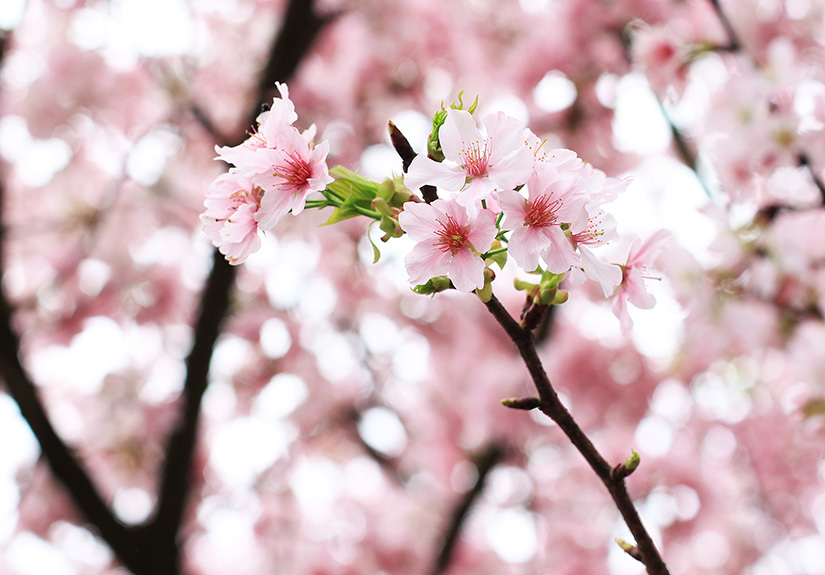Shooting Tips for Summer Lotus Photos
This year is a busy year for flower photo lovers. After cherry blossom, golden trumpet tree and cotton tree, lotus is at its best in summer time. Different from other flower subjects, photographing lotus requires a slightly different set of skills. In this article, we will talk about the equipment and the shooting tips you need to know.
Lotus? Or Sleeping Lotus?
Lotus has a few different names in Chinese. Lotus and sleeping lotus, however, are two different plants. Although they look similar, the two are totally different in taxonomy. The leaves of lotus come out of the water and are in a perfect round shape without slits, while the leaves of sleeping lotus float on the water and there are slits around the edge of the leaves. Besides, the petals of lotus are wider, while the petals of sleeping lotus are more slender. And the two have different blossom periods – that’s what important to photo lovers. Lotus blooms in summer from May to September while sleeping lotus blooms throughout the year.
Lotus Shooting Technique
Make the Subject Stand Out from a Blurry Background
The poem “The Love of Lotus” by Dunyi Zhou is familiar to most of us. One of the characteristics of lotus is that “It raises cleanly above ripples of water and can only be admired from afar, but not to be sullied nor debased.” Simply put, lotus grows from the bottom of a muddy pond, making it impossible to shoot up close. Therefore, in lotus photography, we need a telephoto lens with focal length of 200mm or longer. For example, EF 70-200mm f/2.8L IS II USM with a large aperture and EF 100-400mm f/4.5-5.6L IS II USM with even longer reach that aids in capturing the lotus at the centre of the pond are nice options. Besides, with the use of large aperture and telephoto lens, a blurry background can be created to make the subject stand out.

The photographer made good use of the long focal length to defocus the lotus at the back, creating a sense of depth to the photo
Title:《景深》 Club Canon Member:HenryC
EOS 6D • EF 70-200mm f/2.8L USM • 1/400s • f/5.6 • ISO 100
Title:《景深》 Club Canon Member:HenryC
EOS 6D • EF 70-200mm f/2.8L USM • 1/400s • f/5.6 • ISO 100
Use of Lighting Contrast
Apart from using a shallow depth of field, use of lighting and color contrast can also accentuate the beauty of lotus. For camera settings, we can use the “Landscape” picture style that shows vivid colors and rich gradation, and increase the contrast and color saturation levels a bit based on personal preference. For composition, we can use a monochrome background such as a dark pond or deep green leaves. We can also use a small aperture, low ISO and maximum flash sync speed (e.g. 1/200s) to reduce the ambient lights effect to create a darker background and use a high flash output power to keep the subject optimally exposed.

By shooting from a low angle, this lotus looks sharp and outstanding on a clean background
Title:《Lotus@ShingMung valley park, HongKong》 Club Canon Member:Damoo
EOS 6D • EF 70-200mm f/4L IS USM • 1/200s • f/4 • ISO 100
Title:《Lotus@ShingMung valley park, HongKong》 Club Canon Member:Damoo
EOS 6D • EF 70-200mm f/4L IS USM • 1/200s • f/4 • ISO 100

With an ingenious use of color contrast, the lotus in this photo looks gorgeous on a background of deep green leaves
Title:《心中蓮》 Club Canon Member:Ken
EOS 5D Mark II • EF 70-200mm f/2.8L IS USM • 1/640s • f/2.8 • ISO 200
Title:《心中蓮》 Club Canon Member:Ken
EOS 5D Mark II • EF 70-200mm f/2.8L IS USM • 1/640s • f/2.8 • ISO 200
Understanding the Phases of Bloom
Lotus has a long blossom period. The flower is in different shape and beauty during different phases of bloom. The budding flower, flower with crown-like opened petals, the mature lotus showing the seed pod and lotus with falling petals have their own unique beauty. When shooting, we can try capture lotuses in different phases of bloom in one picture to enrich the composition.

We can tell that it’s the photographer’s intention to capture four lotuses in different phases of bloom from the title
Title:《四代同堂》 Club Canon Member:HenryC
EOS 6D • EF 70-200mm f/2.8L USM • 1/250s • f/5.6 • ISO 100
Title:《四代同堂》 Club Canon Member:HenryC
EOS 6D • EF 70-200mm f/2.8L USM • 1/250s • f/5.6 • ISO 100
The Reflection Beauty
To photograph sleeping lotus which floats on the water, we can include the reflection in the composition. In general, we should shoot on a calm day, when there is a clear reflection in the pond. Although it’s largely by luck, it still requires a certain technique. A front or side lighting will give you a more apparent reflection. As the reflection is dimmer than the subject itself, we can use a Graduated Neutral Density (GND) filter to balance the light on both sides to achieve a clearer reflection. Sometimes we can take picture of merely the reflection to depict the hazy beauty of sleeping lotus.

Title:《水中鏡》 Club Canon Member:Phyllis
EOS 500D • EF-S 18-200mm f/3.5-5.6 IS • 1/1250 • f/5.6 • ISO 1000
EOS 500D • EF-S 18-200mm f/3.5-5.6 IS • 1/1250 • f/5.6 • ISO 1000
Pay Attention to the Surrounding Elements
Although lotus is our subject, we should also pay attention to the surrounding environment. There are many insects and creatures in the pond, for example bee, dragonfly, damselfly and frog, and it would be a nice idea to include them in the composition to add a sense of vitality to your photos. Besides, we can take close-up shots of lotus with dew drops clinging onto the flower in the morning or after rain.

Half covered by its leaf, this lotus with crystal-like dew drops clinging to the petals shows its beauty in full bloom
Title:《花樣年華》 Club Canon Member:Tsang Jing Jing
EOS 60D • EF 70-200mm f/2.8L IS USM • 1/8000s • f/3.5 • ISO 500
Title:《花樣年華》 Club Canon Member:Tsang Jing Jing
EOS 60D • EF 70-200mm f/2.8L IS USM • 1/8000s • f/3.5 • ISO 500
Shooting Locations for Lotus
Wun Chuen Sin Kwoon
Address: Tai Po Tin Village, Ping Che Road, Ping Yeung Village, Ta Ku Ling, N.T.
Opening Hour: 7:30am - 5:30pm
How to go: Take minibus no. 52K at Fanling MTR Station and get off at Wun Chuen Sin Kwoon
Opening Hour: 7:30am - 5:30pm
How to go: Take minibus no. 52K at Fanling MTR Station and get off at Wun Chuen Sin Kwoon
Lions Nature Education Centre
Address: Lions Nature Education Centre, Tsiu Hang, Sai Kung
Opening Hour: 9:30am - 5:00pm, closed on Tuesdays
How to go: Take bus no. 92 or 96R at Diamond Hill MTR Station or minibus no. 1A at Choi Hung MTR Station; get off at Pak Kong bus stop
Opening Hour: 9:30am - 5:00pm, closed on Tuesdays
How to go: Take bus no. 92 or 96R at Diamond Hill MTR Station or minibus no. 1A at Choi Hung MTR Station; get off at Pak Kong bus stop
Shing Mun Valley Park
Address: South Garden, Shing Mun Valley Park, Shing Mun Road, Tsuen Wan
Opening Hour: 6:30am - 11:00pm
How to go: Take Exit B at Tai Wo Hau MTR Station and walk for 15 minutes; change to bus no. 43X at Shing Mun Tunnels Bus Interchange; or take minibus no. 32M at Kwai Fong MTR Station and get off at Shek Kwai House bus stop
Opening Hour: 6:30am - 11:00pm
How to go: Take Exit B at Tai Wo Hau MTR Station and walk for 15 minutes; change to bus no. 43X at Shing Mun Tunnels Bus Interchange; or take minibus no. 32M at Kwai Fong MTR Station and get off at Shek Kwai House bus stop
Shooting Locations for Sleeping Lotus
Chi Lin Nunnery
Address: 5 Chi Lin Drive, Diamond Hill, Kowloon
Opening Hour: 6:30am - 7:30pm
How to go: Take Exit C2 at Diamond Hill MTR Station and walk for around 10 minutes
Opening Hour: 6:30am - 7:30pm
How to go: Take Exit C2 at Diamond Hill MTR Station and walk for around 10 minutes
Weiyuan Lake, The Chinese University of Hong Kong
Address: Chung Chi College, The Chinese University of Hong Kong, Sha Tin
Opening Hour: Open 24 hours
How to go: Take Exit A at University MTR Station and walk for around 5 minutes
Opening Hour: Open 24 hours
How to go: Take Exit A at University MTR Station and walk for around 5 minutes



